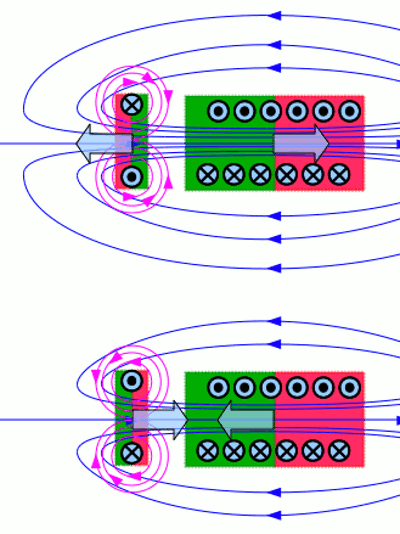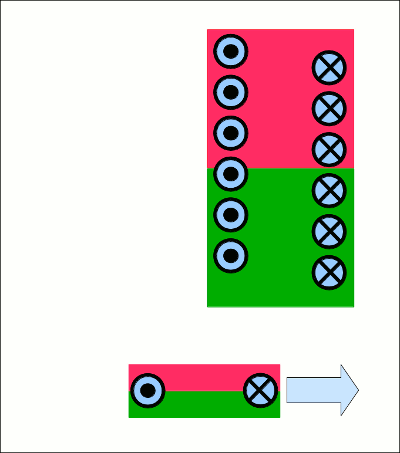|
|
|
|
News The Project Technology RoboSpatium Contribute Subject index Download Responses Games Gadgets Contact <<< Synchronous motor Java-Applet asynchronous motor >>> Asynchronous motorInduction and action of forcesIn the chapter about induction we have learned that a current is generated in a coil if it is exposed to a varrying magnetic field. In the chapter about self-inductance we saw that the thereby generated current is acting contraty to the change in magnetic field strength. Let's have a look at two coils with one bneing energized through an external power source:
Conductive loop near the varrying magnetic field of a coil: At the drawing the coil gets connected to a voltage source. A current starts running through the windings of the coil as described in the chapter about switching operations. Around the coil, a magnetic field is created with it's south pole pointing to the left. The magnetic flux through the conductive loop is increasing and according to Lenz's law a magnetic field is created which counteracts that of the coil. Consequently the magnetic south pole of the conductive loop points to the right, facing the south pole of the coil. A repellent force is acting between the coil and the conductive loop. When lowering the current running through the coil the resulting magnetic field is decreasing. The magnetic flux through the conductor loop is decreasing, too and a current is induced which tries to keep the magnetic flux. Accordingly the magnetic north pole of the conductive loop is now at the right side. An attracting force is acting between the coil and the conductive loop, because the magnetic north pole of the conductive loop points to the south pole of the coil. What happens if an electromagnet moves sideways over the conductive loop? 
An energized coil with its magnetic south pole pointing to the bottom of the arrangement passes a conductive loop. While the electromagnet approaches from the left, the magnetic flux at the core of the conductive loop is increasing. The magnetic field generated by the loop weakenes the field of the coil, thus the magnetic south pole of the loop points upwards, facing the south pole of the coil. The resulting force pushes the loop to the right. The magnetic field is at its maximum if the coil is above the loop. If the coil continues moving to the right, the magnetic flux passing the loop is decreasing. Now, the field induced by the loop is enforcing the magnetic field of the coil, thus the magnetic north pole points upwards, facing the south pole of the coil. There is an attracting force acting between coil and loop, thus the loop is pulled to the right. The horizontal force is always pointing to the direction of movement of the electromagnet! It doesn't matter if the electromagnet is moving from the left to the right or vice versa respectively if the north or south pole of the magnet is pointing to the conductive loop. Its the speed of movement that causes a force pointing into the direction of movement. The higher the speed of movement, the stronger the force. When using a superconductive loop, there will always be a repelling force between loop and coil. The magnetic field of the loop builts up (with the south pole to the top) from zero to it's maximum while the electromagnet approaches from the left and it falls back (with the south pole still pointing to the top) to zero while the electromagnet moves away to the right. If the energy of the current running through the loop is transformed into thermal energy, the current indeed changes direction while the electromagnet moves away. <<< Synchronous motor Java-Applet asynchronous motor >>> News The Project Technology RoboSpatium Contribute Subject index Archives Download Responses Games Links Gadgets Contact Imprint |
|
|